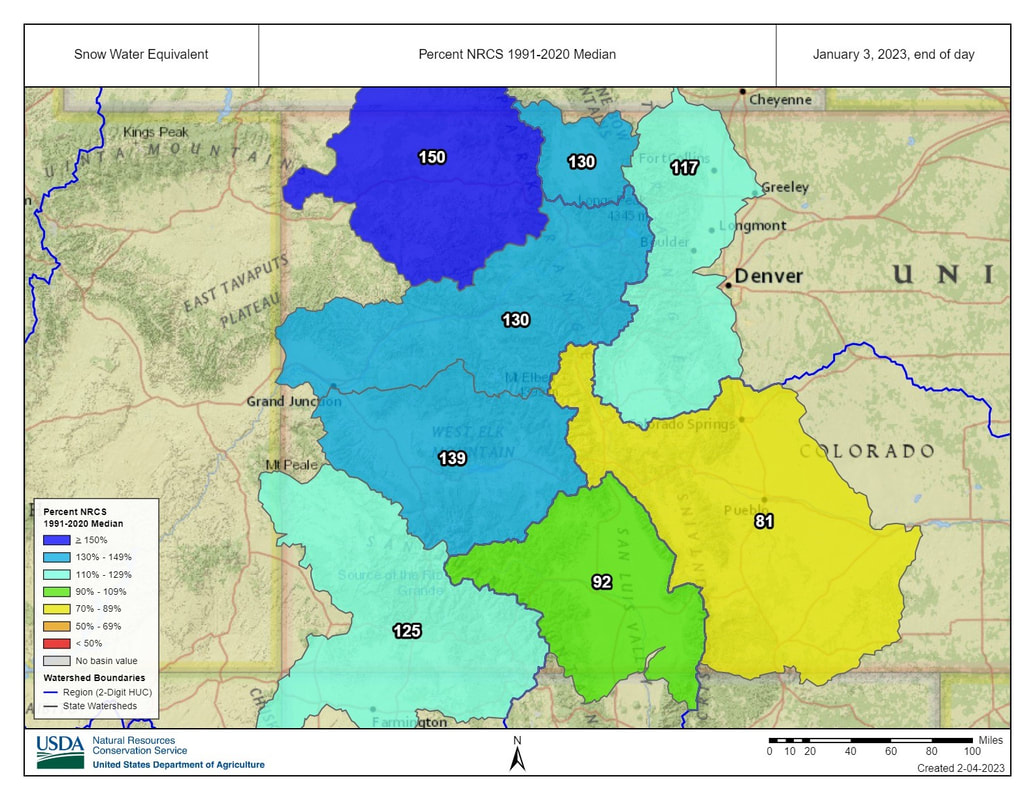|
January was the coldest month since 1988 in Denver, and the cold temperatures and winter storm pattern produced above-average snowpack for the state, with only the Arkansas and Rio Grande basins recording below-average levels of 81% and 94%, respectively. Almost half of Colorado (45.65%), including the Upper Ark Valley, is no longer under drought conditions, according the latest U.S. Drought Monitor report. Moving east across the Plains, Ark Basin conditions range from abnormally dry in the foothills to extreme drought at the Kansas state line. Snowpack
Arkansas Basin Snowpack Telemetry (SNOTEL) site readings for snow-water equivalent range from 36% of median at the Apishipa site near the Spanish Peaks to 127% at St. Elmo in western Chaffee County. The Brumley SNOTEL site, near Independence Pass, reports 91% of median, while Fremont Pass reports 94%. Glen Cove, north of Pikes Peak, is at 108%. Buckskin Joe in South Park reads 62%. In the Sangre de Cristo Range, Hayden Pass reads 49% of median. Reservoir Storage Pueblo Reservoir is 64.1% full with water storage increasing from 195,933 acre-feet to 207,047 in January. Water storage in Turquoise Lake, currently 58.7% full, dropped almost 8,000 acre-feet to 76,014.2. At Twin Lakes storage levels also decreased in January, from 105,754 acre-feet to 99,431.4 acre-feet, or 70.5% full. John Martin Reservoir, which stores water for the Winter Water Storage Program (WWSP), increased from 23,462 acre-feet of water at the end of December to 30,097 acre-feet at the end of January. River Flows In the grips of winter, the flow gauge near Leadville is not reporting Arkansas River flow data. The gauge at Granite in north Chaffee County reports a flow of 162 cfs with ice. The gauge at Wellsville, near Salida, reports 328 cfs, up slightly from December. River flow at Cañon City is 434 cfs, and the flow below Pueblo Reservoir remains little changed from last month at 113 cfs. River flow near Avondale is 267 cfs, also little changed from a month ago. The gauge at Rocky Ford reads 23.8 cfs, a drop of about 80%. Flow below John Martin Reservoir remains low at 0.46 cfs, and the gauge near Lamar reads 14.7 cfs. Calling Water Rights Calling water rights in the Arkansas Basin remain unchanged from the end of December with eight calls for water, and the Maria Stevens Reservoir is authorized to divert water from the Cucharas River under its 1887 storage right. The most senior calling right is the 1862 Chilili Ditch, which began calling for Purgatoire River water Dec. 30, 2022. Otherwise, with the WWSP in effect, calling water rights are limited to:
Comments are closed.
|
Archives
July 2024
Categories |


 RSS Feed
RSS Feed
